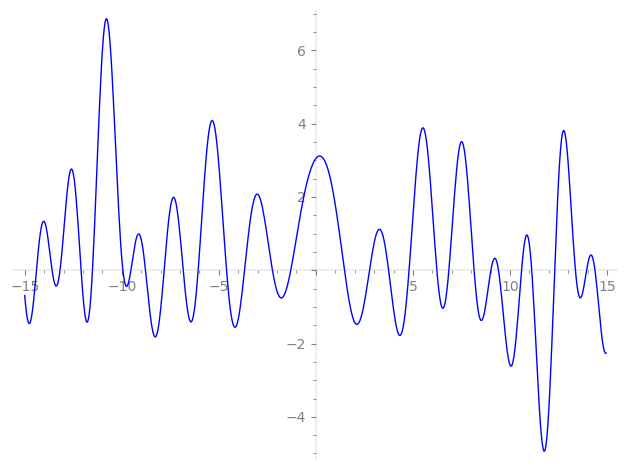| L(s) = 1 | + (2.79 − 1.09i)3-s + (3.24 − 1.87i)5-s + (6.59 − 6.11i)9-s + (15.1 + 8.77i)11-s + 4.69·13-s + (6.99 − 8.77i)15-s + (−19.4 − 11.2i)17-s + (11.7 + 20.3i)19-s + (−5.5 + 9.52i)25-s + (11.7 − 24.3i)27-s − 17.5i·29-s + (23.4 − 40.6i)31-s + (52.0 + 7.85i)33-s + (15 + 25.9i)37-s + (13.0 − 5.13i)39-s + ⋯ |
| L(s) = 1 | + (0.930 − 0.365i)3-s + (0.648 − 0.374i)5-s + (0.733 − 0.679i)9-s + (1.38 + 0.797i)11-s + 0.360·13-s + (0.466 − 0.584i)15-s + (−1.14 − 0.660i)17-s + (0.617 + 1.06i)19-s + (−0.220 + 0.381i)25-s + (0.434 − 0.900i)27-s − 0.605i·29-s + (0.756 − 1.31i)31-s + (1.57 + 0.238i)33-s + (0.405 + 0.702i)37-s + (0.335 − 0.131i)39-s + ⋯ |
\[\begin{aligned}\Lambda(s)=\mathstrut & 588 ^{s/2} \, \Gamma_{\C}(s) \, L(s)\cr =\mathstrut & (0.854 + 0.519i)\, \overline{\Lambda}(3-s) \end{aligned}\]
\[\begin{aligned}\Lambda(s)=\mathstrut & 588 ^{s/2} \, \Gamma_{\C}(s+1) \, L(s)\cr =\mathstrut & (0.854 + 0.519i)\, \overline{\Lambda}(1-s) \end{aligned}\]
Particular Values
| \(L(\frac{3}{2})\) |
\(\approx\) |
\(3.052969641\) |
| \(L(\frac12)\) |
\(\approx\) |
\(3.052969641\) |
| \(L(2)\) |
|
not available |
| \(L(1)\) |
|
not available |
\(L(s) = \displaystyle \prod_{p} F_p(p^{-s})^{-1} \)
| $p$ | $F_p(T)$ |
|---|
| bad | 2 | \( 1 \) |
| 3 | \( 1 + (-2.79 + 1.09i)T \) |
| 7 | \( 1 \) |
| good | 5 | \( 1 + (-3.24 + 1.87i)T + (12.5 - 21.6i)T^{2} \) |
| 11 | \( 1 + (-15.1 - 8.77i)T + (60.5 + 104. i)T^{2} \) |
| 13 | \( 1 - 4.69T + 169T^{2} \) |
| 17 | \( 1 + (19.4 + 11.2i)T + (144.5 + 250. i)T^{2} \) |
| 19 | \( 1 + (-11.7 - 20.3i)T + (-180.5 + 312. i)T^{2} \) |
| 23 | \( 1 + (264.5 - 458. i)T^{2} \) |
| 29 | \( 1 + 17.5iT - 841T^{2} \) |
| 31 | \( 1 + (-23.4 + 40.6i)T + (-480.5 - 832. i)T^{2} \) |
| 37 | \( 1 + (-15 - 25.9i)T + (-684.5 + 1.18e3i)T^{2} \) |
| 41 | \( 1 - 1.68e3T^{2} \) |
| 43 | \( 1 + 50T + 1.84e3T^{2} \) |
| 47 | \( 1 + (-51.8 + 29.9i)T + (1.10e3 - 1.91e3i)T^{2} \) |
| 53 | \( 1 + (75.9 + 43.8i)T + (1.40e3 + 2.43e3i)T^{2} \) |
| 59 | \( 1 + (81.0 + 46.7i)T + (1.74e3 + 3.01e3i)T^{2} \) |
| 61 | \( 1 + (-58.6 - 101. i)T + (-1.86e3 + 3.22e3i)T^{2} \) |
| 67 | \( 1 + (5 - 8.66i)T + (-2.24e3 - 3.88e3i)T^{2} \) |
| 71 | \( 1 - 87.7iT - 5.04e3T^{2} \) |
| 73 | \( 1 + (-23.4 + 40.6i)T + (-2.66e3 - 4.61e3i)T^{2} \) |
| 79 | \( 1 + (-22 - 38.1i)T + (-3.12e3 + 5.40e3i)T^{2} \) |
| 83 | \( 1 + 101. iT - 6.88e3T^{2} \) |
| 89 | \( 1 + (-64.8 + 37.4i)T + (3.96e3 - 6.85e3i)T^{2} \) |
| 97 | \( 1 + 75.0T + 9.40e3T^{2} \) |
| show more | |
| show less | |
\(L(s) = \displaystyle\prod_p \ \prod_{j=1}^{2} (1 - \alpha_{j,p}\, p^{-s})^{-1}\)
Imaginary part of the first few zeros on the critical line
−9.941633037696070728311166918219, −9.529731318292043278857884506460, −8.777430107343524236597485842317, −7.81704810806707892116823024875, −6.83289663606735836864582957188, −6.06435835608822367932504544253, −4.60153523904571178337343585413, −3.67579189664138345555631698986, −2.23874665661907116130931356924, −1.29519666428906996676511101837,
1.47120458121062678982589380799, 2.76076784032613549045760631534, 3.74531090249169356016997425365, 4.79821042533103555573448345597, 6.23110955423561030552417921056, 6.84881291614409871136647343556, 8.147961875185561597976566349877, 9.013094815580676403701698530203, 9.403790905882328744568220321841, 10.59402902082370530571360873621

